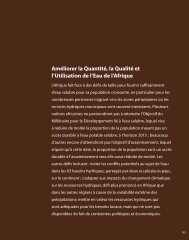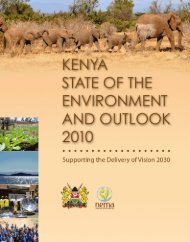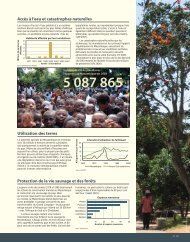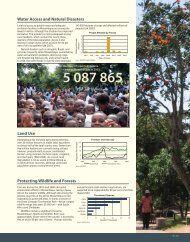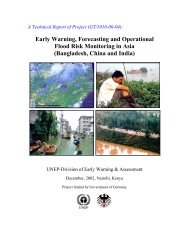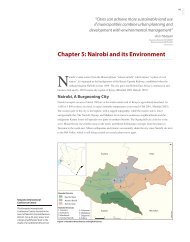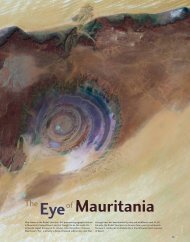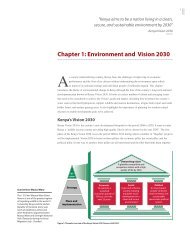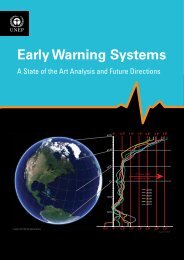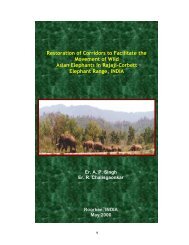Uganda Atlas of Our Changing Environment - GRID-Arendal
Uganda Atlas of Our Changing Environment - GRID-Arendal
Uganda Atlas of Our Changing Environment - GRID-Arendal
Create successful ePaper yourself
Turn your PDF publications into a flip-book with our unique Google optimized e-Paper software.
Conservation areas: Wildlife<br />
Gorillas in Bwindi Impenetrable National Park (2008)<br />
<strong>Uganda</strong> is rich in wildlife resources that are located<br />
in both gazettted areas and on private lands.<br />
In addition to forest reserves, <strong>Uganda</strong> has four<br />
types <strong>of</strong> wildlife protected areas namely national parks,<br />
wildlife reserves, wildlife sanctuaries, and community<br />
wildlife areas; classified according to the degree <strong>of</strong><br />
protection accorded. These areas are entirely for<br />
conservation <strong>of</strong> wildlife. There are six forest national<br />
parks namely Mgahinga, Bwindi impenetrable, Kibale,<br />
Semliki, Rwenzori Mountains and Mt. Elgon.<br />
There are also four savannah ecosystem national parks<br />
namely Lake Mburo, Queen Elizabeth, Murchison Falls,<br />
and Kidepo.<br />
Bwindi Impenetrable National Park<br />
The National parks occupy a total area <strong>of</strong> 11,150 km 2<br />
(4% <strong>of</strong> the country’s area). There are also ten wildlife<br />
reserves which occupy 8,760 km 2 (3.6% <strong>of</strong> the country’s<br />
area) <strong>of</strong> the country’s area, and consist primarily <strong>of</strong><br />
grassland with patches <strong>of</strong> dry woodland and scrubland.<br />
In addition, there are seven wildlife sanctuaries and<br />
thirteen community wildlife areas. Overall, protected<br />
<strong>Uganda</strong> Wildlife Authority (UWA) 2008<br />
57%<br />
Area (sq. km)<br />
wildlife areas occupy about 20% <strong>of</strong> the area <strong>of</strong> <strong>Uganda</strong>,<br />
which is quite a significant proportion.<br />
<strong>Uganda</strong> boasts <strong>of</strong> a diversity <strong>of</strong> wildlife both flora and<br />
fauna species; which are mainly due to a diversity <strong>of</strong><br />
landscapes that lead to different ecosystems ranging<br />
from mountain, tropical forests to savannah grasslands.<br />
The conservation areas habour species <strong>of</strong> both national<br />
and global importance.<br />
The main economic benefit from the wildlife estate has<br />
been revenue earnings from tourism. The other benefits<br />
include cultural and scientific. The conservation <strong>of</strong><br />
<strong>Uganda</strong>’s wildlife resources also has benefits <strong>of</strong> global<br />
significance. Sustainable use <strong>of</strong> these conservation areas<br />
faces many challenges such as increased population<br />
pressure leading to competition for land resources,<br />
and conflict between humans and wildlife. Wildlife<br />
conservation in <strong>Uganda</strong> faces a number <strong>of</strong> threats which<br />
include encroachment on the conservation areas for<br />
agriculture and settlements, poaching, destruction <strong>of</strong><br />
wildlife considered to be vermin.<br />
2%<br />
23%<br />
18%<br />
National Parks<br />
Wildlife reserves<br />
Wildlife sanctuaries<br />
Community wildlife areas<br />
Proportional area coverage <strong>of</strong> each <strong>of</strong> the<br />
conservation categories<br />
39



